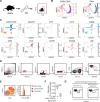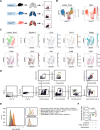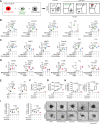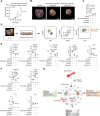Fibrocytes boost tumor-supportive phenotypic switches in the lung cancer niche via the endothelin system
- PMID: 36241617
- PMCID: PMC9568595
- DOI: 10.1038/s41467-022-33458-8
Fibrocytes boost tumor-supportive phenotypic switches in the lung cancer niche via the endothelin system
Abstract
Fibrocytes are bone marrow-derived monocytic cells implicated in wound healing. Here, we identify their role in lung cancer progression/ metastasis. Selective manipulation of fibrocytes in mouse lung tumor models documents the central role of fibrocytes in boosting niche features and enhancing metastasis. Importantly, lung cancer patients show increased number of circulating fibrocytes and marked fibrocyte accumulation in the cancer niche. Using double and triple co-culture systems with human lung cancer cells, fibrocytes, macrophages and endothelial cells, we substantiate the central features of cancer-supporting niche: enhanced cancer cell proliferation and migration, macrophage activation, augmented endothelial cell sprouting and fibrocyte maturation. Upregulation of endothelin and its receptors are noted, and dual endothelin receptor blockade suppresses all cancer-supportive phenotypic alterations via acting on fibrocyte interaction with the cancer niche. We thus provide evidence for a crucial role of fibrocytes in lung cancer progression and metastasis, suggesting targets for treatment strategies.
© 2022. The Author(s).
Conflict of interest statement
The authors declare no competing interests.
Figures










Similar articles
-
Bone marrow-derived fibrocytes promote stem cell-like properties of lung cancer cells.Cancer Lett. 2018 May 1;421:17-27. doi: 10.1016/j.canlet.2018.02.016. Epub 2018 Feb 12. Cancer Lett. 2018. PMID: 29448000
-
Circulating fibrocytes prepare the lung for cancer metastasis by recruiting Ly-6C+ monocytes via CCL2.J Immunol. 2013 May 1;190(9):4861-7. doi: 10.4049/jimmunol.1202857. Epub 2013 Mar 27. J Immunol. 2013. PMID: 23536638 Free PMC article.
-
Pirfenidone inhibits fibrocyte accumulation in the lungs in bleomycin-induced murine pulmonary fibrosis.Respir Res. 2014 Feb 8;15(1):16. doi: 10.1186/1465-9921-15-16. Respir Res. 2014. PMID: 24507087 Free PMC article.
-
Fibrocytes in the Tumor Microenvironment.Adv Exp Med Biol. 2020;1224:79-85. doi: 10.1007/978-3-030-35723-8_6. Adv Exp Med Biol. 2020. PMID: 32036606 Free PMC article. Review.
-
Hypoxia, leukocytes, and the pulmonary circulation.J Appl Physiol (1985). 2005 Feb;98(2):715-21. doi: 10.1152/japplphysiol.00840.2004. J Appl Physiol (1985). 2005. PMID: 15649883 Review.
Cited by
-
ADPGK-AS1 long noncoding RNA switches macrophage metabolic and phenotypic state to promote lung cancer growth.EMBO J. 2023 Sep 18;42(18):e111620. doi: 10.15252/embj.2022111620. Epub 2023 Aug 7. EMBO J. 2023. PMID: 37545364 Free PMC article.
-
Endothelin and the tumor microenvironment: a finger in every pie.Clin Sci (Lond). 2024 Jun 5;138(11):617-634. doi: 10.1042/CS20240426. Clin Sci (Lond). 2024. PMID: 38785410 Free PMC article. Review.
-
The functionality of a therapeutic antibody candidate restored by a single mutation from proline to threonine in the variable region.Hum Vaccin Immunother. 2023 Dec 15;19(3):2279867. doi: 10.1080/21645515.2023.2279867. Epub 2023 Nov 27. Hum Vaccin Immunother. 2023. PMID: 38012091 Free PMC article.
-
The extracellular matrix protein type I collagen and fibronectin are regulated by β-arrestin-1/endothelin axis in human ovarian fibroblasts.J Exp Clin Cancer Res. 2025 Feb 21;44(1):64. doi: 10.1186/s13046-025-03327-5. J Exp Clin Cancer Res. 2025. PMID: 39985042 Free PMC article.
-
Targeting the activated allosteric conformation of the endothelin receptor B in melanoma with an antibody-drug conjugate: mechanisms and therapeutic efficacy.BJC Rep. 2025 Jan 20;3(1):3. doi: 10.1038/s44276-024-00109-y. BJC Rep. 2025. PMID: 39833448 Free PMC article.
References
-
- Chesney J, Metz C, Stavitsky AB, Bacher M, Bucala R. Regulated production of type I collagen and inflammatory cytokines by peripheral blood fibrocytes. J. Immunol. 1998;160:419–425. - PubMed
Publication types
MeSH terms
Substances
LinkOut - more resources
Full Text Sources
Medical
Molecular Biology Databases

